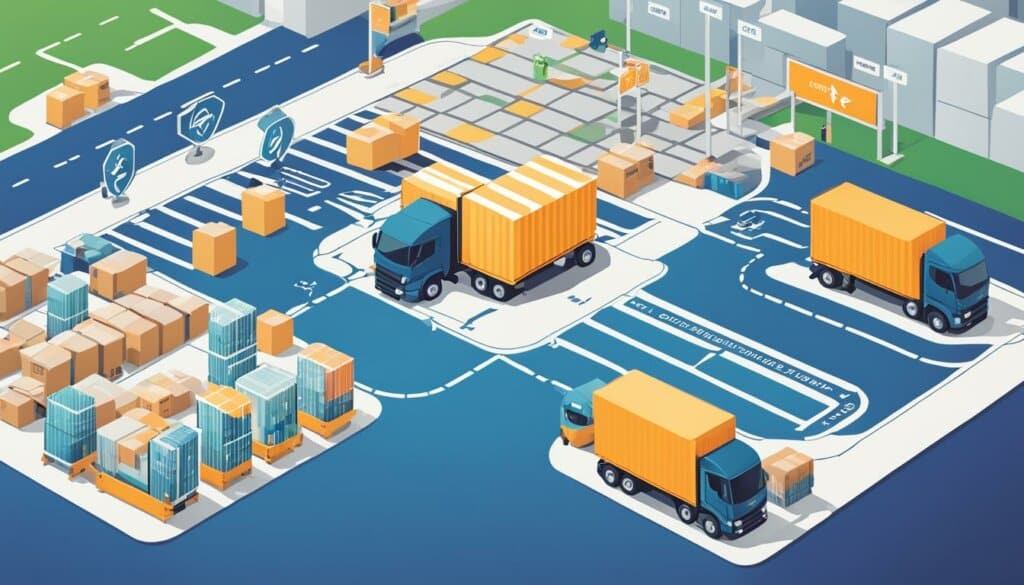Table of Contents
E-commerce businesses must prioritize optimizing their shipping strategies to improve customer satisfaction and maximize profitability. In this article, we will provide expert guidance on how to make your logistics a competitive advantage through strategic e-commerce shipping options. By optimizing your shipping strategy, you can streamline your operations, meet customer expectations, and drive business growth.
Effective shipping strategies can differentiate your business from competitors, enhance the post-purchase experience, and build customer loyalty. Whether you are a small online retailer or a large e-commerce platform, refining your shipping processes is crucial.
Throughout this article, we will explore key aspects of e-commerce shipping, including the shipping process, best practices to follow, calculating shipping costs, packaging options, shipment tracking, and return management. Each section will provide valuable insights and actionable tips to help you optimize your e-commerce shipping strategy and achieve lasting success in the digital marketplace.
What is Ecommerce Shipping?
Ecommerce shipping is the backbone of any online business. It encompasses a series of essential processes and tasks involved in fulfilling customer orders and delivering products to their doorstep. From receiving and processing orders to picking, packing, printing shipping labels, and managing returns, ecommerce shipping plays a vital role in providing a seamless customer experience.
Receiving and Processing Orders
Upon receiving an order, it is crucial for businesses to verify its accuracy and completeness. This step involves checking the product details, quantities, and customer shipping information. By ensuring order accuracy from the beginning, businesses can minimize errors and prevent delays in the shipping process.
Picking and Packing
Once an order is verified, the next step is picking and packing the products. This involves locating the items in the warehouse, carefully inspecting them for quality, and packing them securely for shipping. An organized and efficient warehouse layout, along with accurate inventory management, is key to streamlining the picking and packing process.
Printing Shipping Labels
After the products are packed, the next task is printing shipping labels. These labels contain important information such as the customer’s address, barcode, and tracking number. Printing accurate and legible shipping labels ensures smooth transit and allows customers to track their packages.
Managing Returns
Managing returns is an integral part of ecommerce shipping. Handling returns efficiently contributes to customer satisfaction and loyalty. It involves setting up a clear and user-friendly return policy, providing return labels, and processing refunds or replacements promptly.
Efficiently managing all these aspects of ecommerce shipping is crucial for businesses to meet customer expectations and maintain a competitive edge. By investing in robust shipping processes and utilizing technology solutions, businesses can streamline their operations and facilitate hassle-free order fulfillment.
| Ecommerce Shipping Tasks | Key Considerations |
|---|---|
| Receiving and processing orders | Order accuracy and verification |
| Picking and packing | Inventory management and efficient warehouse layout |
| Printing shipping labels | Accurate and legible information |
| Managing returns | Clear return policy and prompt processing |
Properly handling ecommerce shipping tasks ensures that orders are processed and fulfilled accurately, leading to timely and satisfactory deliveries. By optimizing each step of the process, businesses can enhance their shipping operations, boost customer satisfaction, and drive long-term success.
Ecommerce Shipping Process
The ecommerce shipping process is a crucial component of successful online businesses. It involves a series of meticulous steps, starting from the moment an order is received to the final shipment of the product to the customer’s doorstep. Let’s explore each stage of the process and understand its significance.
Order Processing
Order processing is the first step in the ecommerce shipping process. It involves verifying and validating customer orders, ensuring the accuracy of product details, and checking inventory availability. This stage requires meticulous attention to detail to ensure that the right products are selected for shipment.
Efficient order processing hinges on a streamlined system that integrates seamlessly with inventory management software. This integration allows businesses to maintain real-time inventory data, minimizing the risk of overselling or shipping inaccuracies.
Inventory Management
Effective inventory management is a vital aspect of the ecommerce shipping process. It involves overseeing product stock levels, ensuring optimal quantities are available for order fulfillment, and avoiding stockouts. By closely monitoring inventory, businesses can provide accurate information to customers regarding product availability and shipping timelines.
Inventory management systems also enable businesses to identify slow-moving items or popular products that require restocking. This data-driven approach helps maintain a well-balanced inventory and avoids any unnecessary delays in the shipping process.
Pick, Pack, and Ship
The pick, pack, and ship stage is where the physical fulfillment process takes place. This involves carefully picking the correct products from inventory, securely packing them in appropriate packaging materials, and preparing them for shipment.
During this stage, it is essential to prioritize accurate order fulfillment and efficient packaging. Adequate protection should be provided to prevent any damage during transit, ensuring that products arrive in excellent condition.
Furthermore, businesses can optimize the pick, pack, and ship process by strategically organizing the warehouse layout and utilizing technology such as barcode scanners and automated packing systems. These tools contribute to increased efficiency and reduced errors during fulfillment.
Once the products are packed, shipping labels are generated, and the packages are handed over to a reliable carrier. Tracking numbers and shipping notifications are shared with customers, allowing them to monitor the progress of their orders.
Benefits of an Efficient Ecommerce Shipping Process
| Benefits | Description |
|---|---|
| Improved Customer Experience | An efficient shipping process ensures timely delivery, accurate order fulfillment, and effective communication, enhancing the overall customer experience. |
| Increased Operational Efficiency | An optimized shipping process minimizes errors, reduces fulfillment time, and improves productivity, resulting in cost savings and improved profitability. |
| Enhanced Brand Reputation | Reliable and seamless shipping processes contribute to a positive brand image and foster customer trust and loyalty. |
| Reduced Returns and Complaints | An efficient shipping process reduces the likelihood of errors, such as shipping the wrong product or delivering damaged items, leading to fewer returns and customer complaints. |
By establishing an efficient ecommerce shipping process that encompasses order processing, inventory management, and pick, pack, and ship stages, businesses can deliver exceptional customer experiences while optimizing operational efficiency.
Best Practices to Follow for Ecommerce Shipping
To optimize ecommerce shipping, it’s important to follow best practices. By implementing these strategies, businesses can enhance their shipping operations, align their teams, and achieve their goals. Here are some key best practices to consider:
Assemble a Great Team of Stakeholders
Building a strong team is crucial for successful ecommerce shipping. Identify individuals with relevant expertise and assign clear roles and responsibilities. Collaborate with stakeholders from various departments, such as logistics, customer service, and operations, to ensure effective coordination and communication throughout the shipping process.
Set Clear Goals
Establishing clear goals is essential for guiding your shipping strategy and measuring success. Identify key performance indicators (KPIs) that align with your business objectives, such as on-time delivery rates, customer satisfaction ratings, or cost reduction targets. Regularly monitor and evaluate these goals to track progress and make necessary adjustments.
Launch a Shipping Strategy
A well-defined shipping strategy is critical for streamlining operations and maximizing efficiency. Consider factors such as shipping options, carrier partnerships, and packaging solutions. Evaluate different delivery methods, such as standard shipping, expedited shipping, or same-day delivery, to offer flexibility to customers. Additionally, assess the viability of outsourcing fulfillment or utilizing third-party logistics providers to optimize your shipping processes.
Ensure Team Alignment
Effective team alignment is key to seamless ecommerce shipping. Foster open communication and collaboration between your shipping team and other departments, such as marketing, sales, and customer service. Regularly meet as a team to discuss challenges, share insights, and identify areas for improvement. Encourage cross-functional training to enhance overall understanding of the shipping process and promote teamwork.
Goal Setting and Continuous Improvement
Continuously improve your ecommerce shipping operations by setting new goals and striving for excellence. Encourage your team to identify areas for optimization, innovation, and cost reduction. Regularly review and adjust your shipping strategy based on customer feedback, industry trends, and performance metrics. Foster a culture of continuous improvement to drive long-term success.
“Effective team alignment and continuous improvement are key to successful ecommerce shipping operations.”
Following these best practices will help you enhance your ecommerce shipping strategy, streamline operations, and ultimately provide a seamless shipping experience for your customers.

| Benefits of Following Best Practices for Ecommerce Shipping | Challenges Addressed |
|---|---|
| Improved customer satisfaction | Lack of coordination between teams |
| Efficient order processing and fulfillment | Inaccurate shipping addresses |
| Cost savings through optimized shipping processes | Delayed deliveries |
| Enhanced brand reputation | Poor packaging choices |
| Reduced errors and returns | High shipping costs |
Calculating Ecommerce Shipping Costs
When it comes to ecommerce, shipping costs play a crucial role in determining customer satisfaction and overall profitability. As an online business, accurately calculating shipping costs is essential to ensure that your pricing strategy aligns with customer expectations and maintains profitability.
Calculating ecommerce shipping costs involves considering various factors:
- Product Weight: The weight of the product impacts the shipping costs as heavier items may require larger packaging and incur higher carrier charges.
- Shipping Distance: The distance between your warehouse and the customer’s location affects shipping costs, with greater distances often resulting in higher rates.
- Carrier Rates: Different carriers have varying pricing structures, so it’s important to compare rates and choose the most cost-effective option for your business.
- Packaging Materials: The type and quantity of packaging materials required to safely ship the product impact shipping costs. Consider the cost of boxes, tape, cushioning materials, and any additional packaging supplies.
Once you have considered these factors, you can then decide on a pricing strategy that best meets your business needs and customer expectations:
- Free Shipping: Offering free shipping is a popular strategy to attract customers and increase order value. However, businesses must carefully calculate the average shipping costs and incorporate them into the product prices.
- Flat Rate Shipping: Implementing a flat rate shipping method simplifies the shipping cost structure for customers. It offers transparency and predictability, making it easier for customers to make purchasing decisions.
- Table Rate Shipping: With table rate shipping, businesses define shipping costs based on specific variables like order value, weight, or destination. This strategy allows for a flexible and tailored approach to shipping costs.
Choosing the right pricing strategy requires careful consideration of your product range, target market, and overall business goals. By accurately calculating ecommerce shipping costs and implementing an effective pricing strategy, you can provide a seamless shipping experience for your customers while maintaining profitability.
Ecommerce Packaging Options
Ecommerce businesses need to carefully consider their packaging options to ensure the protection of their products, enhance brand presentation, and meet sustainability goals. The right packaging not only safeguards the item during transit but also contributes to a positive unboxing experience for the customer.
When choosing ecommerce packaging, several variables should be taken into account. One important consideration is selecting the appropriate box size to accommodate the product securely. If the box is too large, the item may move around during shipping, leading to potential damage. On the other hand, if the box is too small, it may not provide enough cushioning and protection.
Protective materials are another crucial aspect to consider. Bubble wrap, packing peanuts, and inflatable air pillows can help safeguard fragile items, prevent them from shifting, and minimize the risk of breakage. Utilizing high-quality packaging materials ensures that products arrive at the customer’s doorstep in pristine condition.
Moreover, businesses should prioritize sustainable packaging solutions to reduce their ecological footprint. Eco-friendly packaging alternatives, such as biodegradable or compostable materials made from recycled sources, can help minimize waste and demonstrate a commitment to environmental responsibility.
Investing in high-quality packaging not only protects the product but also contributes to brand presentation. The packaging design should align with the brand image and communicate its values. Customized branded packaging helps create a memorable unboxing experience for customers, enhancing their perception of the product and the overall brand.
Kate Ryan, co-founder of Sustainable Co., emphasizes the significance of sustainable packaging in ecommerce: “In today’s market, consumers are increasingly conscious of the environmental impact of their purchases. By incorporating sustainable packaging options, businesses can align themselves with customer values and differentiate themselves from competitors.”
To summarize, ecommerce businesses should carefully consider packaging options to ensure product protection, enhance brand presentation, and meet sustainability goals. By selecting the appropriate box sizes, utilizing protective materials, and embracing eco-friendly packaging alternatives, businesses can deliver a positive customer experience while demonstrating a commitment to the environment.
How to Track Ecommerce Shipments and Returns
Tracking ecommerce shipments and managing returns are crucial for ensuring customer satisfaction and maintaining a seamless post-purchase experience. By utilizing tracking technologies, providing order status updates, and streamlining return processes, businesses can enhance customer trust and loyalty. Effective communication with customers during these processes is also essential for building strong relationships and resolving any concerns or issues.
Order tracking is a fundamental element of ecommerce shipping that enables customers to monitor the progress of their shipments and anticipate delivery. By implementing a reliable tracking system, businesses can proactively update customers on the status of their orders, including estimated arrival dates and any potential delays. This transparency not only keeps customers informed but also reduces inquiries and minimizes frustration.
Return management plays a vital role in customer satisfaction and should be handled with care. By providing a straightforward and user-friendly return process, businesses demonstrate their commitment to resolving any product-related issues promptly. Clear instructions, prepaid return labels, and return portals can simplify the returns process for customers, ensuring their convenience and convenience.
To effectively track ecommerce shipments and manage returns, businesses should consider implementing the following strategies:
- Utilize advanced tracking technologies: Implement a reliable tracking system that allows customers to easily track their shipments online. This can include providing tracking numbers and enabling real-time updates through email or SMS notifications.
- Provide regular order status updates: Keep customers informed about the progress of their shipments by sending regular updates, including expected delivery dates and any significant changes or delays.
- Streamline return processes: Simplify the return process by offering clear instructions, prepaid return labels, and a user-friendly return portal. Ensure customers have a hassle-free experience when returning products.
- Invest in customer communication: Establish effective communication channels to address customer inquiries, concerns, or issues regarding shipments or returns. Promptly respond to customer queries and provide personalized assistance as needed.
To illustrate the importance of tracking ecommerce shipments and managing returns effectively, let’s take a look at a case study:
“At ABC Electronics, we implemented a state-of-the-art tracking system that allowed our customers to monitor their shipments from the moment they placed an order. By providing real-time updates and estimated delivery dates, we saw a significant decrease in inquiries related to order status. Additionally, we revamped our return process by offering prepaid return labels and a user-friendly return portal. As a result, our return rates reduced by 30% and customer satisfaction improved dramatically.”
– Jane Smith, Operations Manager at ABC Electronics
Tracking ecommerce shipments and managing returns are critical components of a successful e-commerce business. By implementing efficient tracking technologies, providing regular updates, streamlining return processes, and prioritizing effective customer communication, businesses can enhance customer satisfaction and build long-lasting relationships.

Conclusion
Optimizing e-commerce shipping strategies is essential for businesses to gain a competitive advantage in the market. By focusing on strategic shipping options, such as free shipping promotions or flat rate shipping, businesses can enhance customer satisfaction and increase profitability. Effective implementation of these strategies, coupled with continuous analysis and improvement, can drive long-term success in the e-commerce industry.
One of the key advantages of optimizing e-commerce shipping is the ability to improve logistics operations. By aligning teams and setting clear goals, businesses can streamline the shipping process, reducing errors and delays. This leads to faster and more reliable deliveries, resulting in happier customers and higher customer satisfaction rates.
Furthermore, profitable e-commerce shipping strategies not only benefit customers but also contribute to the overall profitability of the business. When businesses efficiently manage their shipping operations, they can control costs, negotiate favorable carrier rates, and avoid unnecessary overhead. This maximizes profit margins and allows businesses to invest in other areas of growth.
To sum up, implementing effective e-commerce shipping strategies offers multiple advantages, including improved logistics operations, increased customer satisfaction, and enhanced profitability. By continuously analyzing and optimizing shipping processes, businesses can stay ahead of the competition and thrive in the ever-evolving e-commerce landscape.
FAQ
What is e-commerce shipping?
E-commerce shipping refers to the entire process of receiving and processing orders, picking and packing products at a warehouse, printing shipping labels, and managing returns. It involves tasks such as inventory management, order verification, and ensuring timely and accurate delivery.
What does the e-commerce shipping process involve?
The e-commerce shipping process encompasses all the steps from receiving and processing an order to picking, packing, and shipping the product to the customer. It involves tasks like checking inventory availability, verifying shipping addresses, and preparing the items for shipment. Efficient management of the shipping process is crucial for delivering a seamless customer experience.
What are the best practices to follow for e-commerce shipping?
To optimize e-commerce shipping, it’s important to follow best practices such as assembling a great team of stakeholders, setting clear goals, and launching a shipping strategy. Good team alignment, goal setting, and continuous improvement are key to successful shipping operations.
How do you calculate e-commerce shipping costs?
Calculating e-commerce shipping costs requires consideration of factors such as product weight, shipping distance, carrier rates, and packaging materials. Businesses can choose between different pricing strategies like free shipping, flat rate shipping, and table rate shipping to meet customer expectations while maintaining profitability.
What are the packaging options for e-commerce?
E-commerce businesses should carefully consider packaging options to ensure product protection, enhance brand presentation, and meet sustainability goals. Variables to consider include appropriate box sizes, protective materials, and eco-friendly packaging alternatives.
How can I track my e-commerce shipments and manage returns?
Tracking e-commerce shipments and managing returns are vital for customer satisfaction. Businesses can utilize tracking technologies, provide order status updates, and streamline return processes to enhance the post-purchase experience. Effective communication with customers during these processes is crucial.













